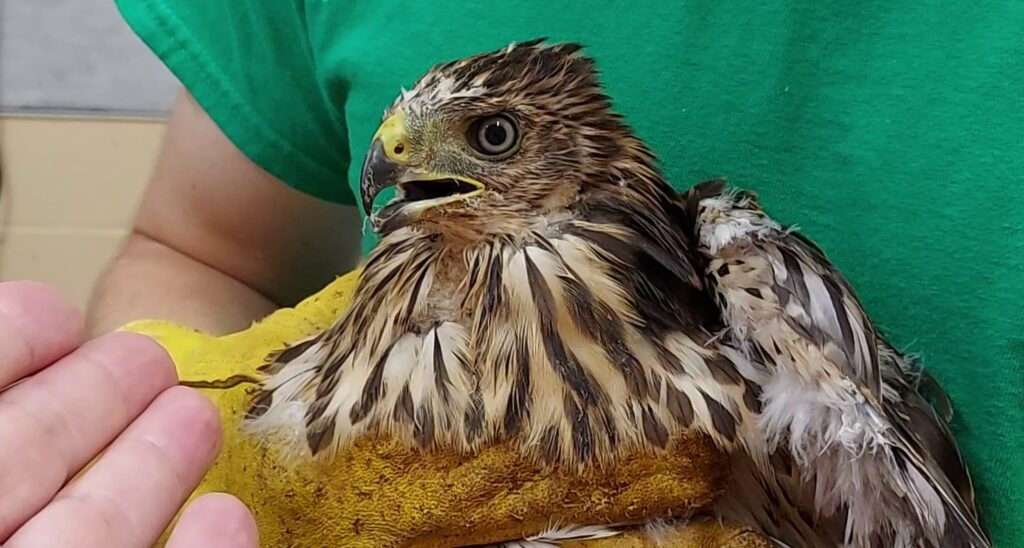By Freddy Moyano
Correspondent
BROWN COUNTY – Recall in the late part of spring when we were told by Lori Bankson, curator of animals at the Bay Beach Wildlife Sanctuary’s (BBWS), that their observation building was experiencing one of their busiest times of the year?
This, Bankson said, was mainly due to newborn animals in need of rescue, such as baby cottontail rabbits and baby raccoons.
The month of July, however, is when things usually slow down.
“With the hotter days we had in July, people have been home more, away from hot temps and their landscaping activities, so the number of animals coming in has decreased,” Bankson said. “It’s a very different time of the year compared to April, May and June.”
Even though some cottontail rabbits, for instance, are bringing to the world their fifth litter of the year, it is still not enough to cause a spike in emergency rescues.
Bankson said this calmer time of the year has allowed their staff to catch up on cleaning cages and releasing some already rehabilitated species back into the wild.
She said storms can be a threat to a lot of birds, including robins, which are in their second hatches, mourning doves already in their third hatches, and goldfinches which are still in their first hatch.
Cooper’s hawks
Our rehabilitation animal of the month, the Cooper’s hawk, was presented to us in a pair of two immature specimens who were two to three weeks apart.
Bankson said the first juvenile hawk – a male who reacted with evasive head maneuvers every time we got closer – was found in the Oshkosh area and brought in around mid-July.
“They are learning how to fly and hunt, but they have a hard time getting food,” Bankson said. “People find them and we help them out.”
Bankson said this particular specimen came in very malnourished.
About a week later, BBWS Wildlife Rehabilitator intern Isaiah Keiler brought in a slightly larger, seven- to eight-week-old female Cooper’s hawk that was rushed in from De Pere.
“She had a hard time adapting when she came in, but she is starting to hand-feed from us on her own,” Keiler said. “She is gaining weight, which is a good thing. She still is a bit thin, so we are going to tube-feed her a dietary paste for birds of prey.”
Bankson said Cooper’s hawks have adapted very well to urban settings.
“We have seen more and more, especially as bird-feeding becomes more popular,” she said, pointing out these birds of prey primarily feed on smaller birds.
“Right now they feed on small chickens and small pheasants, as well as the special food paste,” Bankson said.
The same weight-gaining technique is being applied to the younger male hawk from Oshkosh, along with learning how to fly and hunt.
Bankson said these two hawks, in spite of being the same species, are best kept in separate cages due to the risk that they can get very hungry – to the point of eating each other.
At all times during our visit to the observation building, Bankson and Keiler were wearing protective gloves due to the sharp talons of both specimens, especially the larger female, whose legs were far more developed than her 3-week-old counterpart.
The tail feathers were more developed in the female specimen, too.
Bankson said as the hawks gain strength, they do not need a lot of flight training because they can get their wings off the ground easily as soon as they are strong enough.”
Bankson said it will still be a few weeks before these two are released.
Teaching them how to hunt is the next logical step after they take flight on their own in bigger cages.
“We put them in areas with house sparrow nests, making sure they are finding that food on their own” Bankson said.

Snowy owl update
Bankson shared a brief update about our March rehabilitation animal of the month, a snowy owl who came in from Kewaunee County with a broken wing.
“She is not progressing as fast as we would like, but we are confident we will be able to release her in the fall,” Bankson said.
How to help
Bankson said if you find an animal in obvious need of help, you should call the sanctuary’s animal care line at (920) 391-3685.
“Not all animals require long-term help,” she said, noting some species need to be put back into their nest, den or habitat area.
Bankson said volunteers are always needed, and anyone interested can find more information at baybeachwildlife.com.
